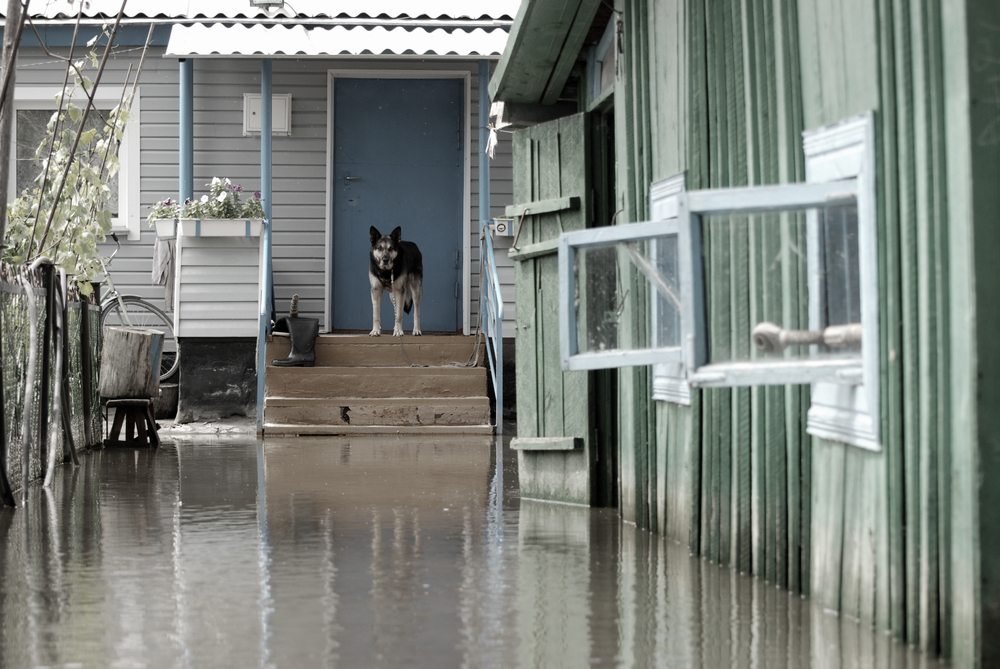When faced with severe weather or a natural disaster, your best defense is preparedness. A catastrophic event can occur quickly, often without warning, and that can spell disaster for you and your pet if no preparations have been made. In the event of flooding, a severe storm, tornado, or fire—all possibilities here in Ohio—you must be prepared to shelter or evacuate with your pet. The best time to plan for an emergency is before a threat occurs, and our Liberty Veterinary Hospital team has the tips you should follow to ensure your pet is protected if disaster strikes.
Prepare emergency supplies for your pet
A pet emergency kit should contain items to help your pet survive and stay comfortable during an emergency situation, whether you must shelter in place or evacuate. Include these essential items in your pet’s emergency kit:
- Food and water — Store enough dry or canned pet food and water to last at least three days. Rotate the stored food and water every few months to ensure freshness.
- Medication — If your pet takes any medication, keep a supply in the emergency kit, along with instructions on how to administer the drug.
- Leash and collar — Have a sturdy leash and collar on hand to keep your pet under control during a catastrophic event.
- Carrier — Have a large, sturdy carrier in which your pet can comfortably stand, turn around, and lie down.
- Blankets and towels — Include a few blankets and towels to keep your pet warm and dry.
- Health records — Keep a copy of your pet’s medical records, vaccination records, and identification information in the emergency kit.
- Toys and treats — Include some of your pet’s favorite toys and treats to help keep them calm and occupied during the disaster.
- Pet first aid kit — Keep a basic first aid kit that includes items such gauze, bandages, antiseptic, and tweezers.
- Sanitation supplies — Include items such as waste bags, paper towels, and disinfectant to keep your pet’s area clean.
- Emergency contact information — Keep a list of emergency contact information, including the address and phone number for your veterinarian, nearby pet-friendly shelters, and animal control facilities.
Keep your pet’s identification up-to-date
Unexpected catastrophic events can separate pets from their owners, and after a disaster, many displaced pets never get back home. If a person finds your lost pet, they can locate you when you ensure your four-legged pal is wearing a collar with an identification tag that includes your name and up-to-date contact information.
In addition, microchipping your pet greatly increases the likelihood that you will be reunited if your four-legged friend becomes lost. A microchip is a tiny transceiver that contains your contact information and a unique identification (ID) number, which is registered in a nationwide database. The microchip implantation procedure is quick and safe, and provides your pet with lifelong permanent identification. When a veterinarian or animal shelter employee scans your pet with a radio frequency identification device (RFID), the chip sends its ID number to the reader, locates your phone number in the database, and contacts you. To ensure you can be reached if you are separated from your microchipped pet, always keep your contact information current in the nationwide database.
Create an emergency plan for your pet

Create a written action plan, review the information with everyone in your family, and keep the document with your pet’s emergency supplies. Your plan should include considerations for sheltering in place with your pet, as well as evacuating. Consider the following when creating your plan:
- Pet-friendly lodging — Keep a list of pet-friendly hotels located along your evacuation route, and include the accommodations’ contact information. In addition, identify friends or family who are willing to provide temporary housing for your pet in case of an emergency. Keep your pet’s vaccines up-to-date at all times, because many shelters and boarding facilities require proof.
- Transportation — Ensure you have a crate or carrier in which you can safely transport your pet. Keep your pet’s emergency supplies stored in a location where you can grab them quickly.
- Sheltering in place —Plan how you will distract and comfort your pet during a disaster if you are sheltering in place at home. Even if you will be staying home, secure your pet inside their crate, and distract them from the sights and sounds outside by providing the following:
- Toys and puzzles — Engaging toys and puzzles that require your pet to solve problems help focus their attention during a stressful situation.
- Calming tools — Calming vests, pheromones, or veterinary-prescribed anti-anxiety medication can help soothe your pet during an emergency.
Planning for a disaster today can save your pet’s life in the future. Ensure your pet is healthy and up-to-date on their vaccinations by scheduling a wellness exam with our Liberty Veterinary Hospital team.








Leave A Comment